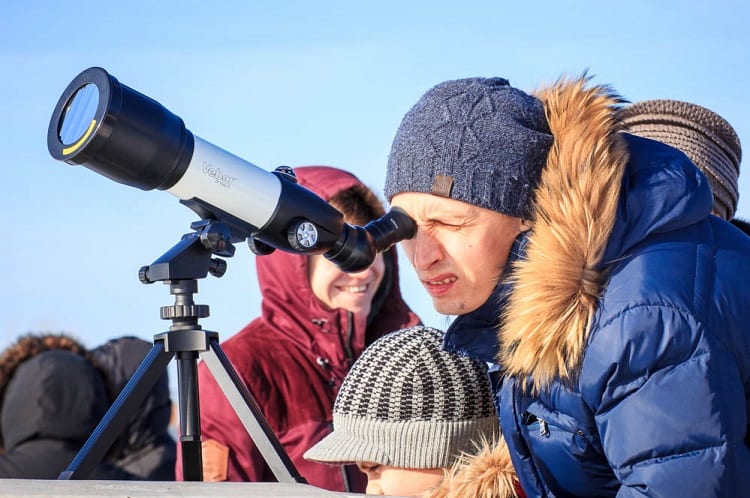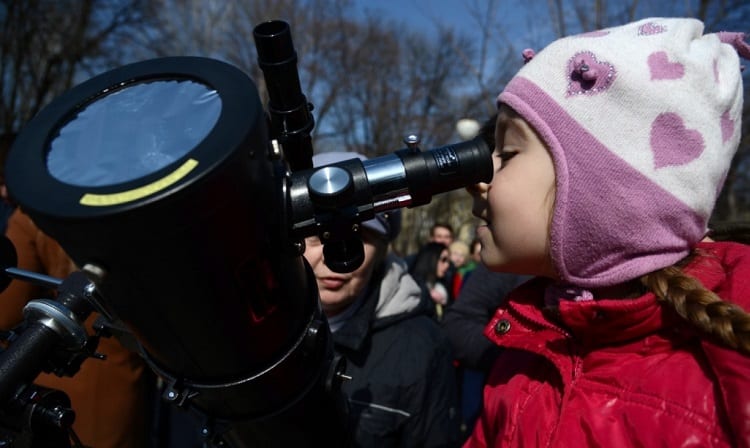If you’re interested in astronomy, you might jump at the chance of getting to work with NASA.
But can you do this just by joining an astronomy club?
There is a way!
How is NASA involved with astronomy clubs?
If your astronomy club is a member of the Night Sky Network outreach program you’ll be given access to resources to help NASA bring science education to the community.
That’s pretty cool, but where do you start?
Here’s everything you need to know about working with NASA as an amateur astronomer.
Contents
What Is The Night Sky Network?
The Night Sky Network is a nationwide partnership of amateur astronomy clubs.
It strives to bring technology, science, as well as the inspiration of NASA’s work to the general public. The Network shares its time to provide people with unique astronomy experiences.
Is Your Astronomy Club Part Of The Network?
If you reside in the U.S., you could team up with NASA just by joining an astronomy club. You just have to make sure that your astronomy club is one of the clubs that are part of the Night Sky Network.
You can find out if your astronomy club has membership by checking out a list of clubs on the Night Star Network website.
What Will You Do As A Club Member?

As a member of the Night Sky Network outreach program, you’ll be sharing your time (and possibly your telescope!) with people in the community so that you can inform the public about astronomy, whether at observatories, schools, museums, or other places.
You might wonder if you need to be an actual astronomer in order to offer your services, but you don’t!
Amateur astronomers who have an interest in helping members of the public learn about basic astronomy concepts in fun and engaging ways can sign up. It obviously helps to be passionate about astronomy and have some knowledge to impart to others.
Who Runs The Club?
Your astronomy club will need at least one primary club coordinator and a backup club coordinator to take the place of the primary coordinator if he or she is unavailable.
The club coordinator will have important tasks, such as:
- Receiving the Outreach Toolkits (more on those in a bit);
- Introducing services of the Night Sky Network as well as the toolkits to other members in the club;
- Maintaining a list of members who are participants in the Night Sky Network;
- Organizing events as well as approving the events that other club members have decided to do. “Events” refers to the work club members will do, such as speaking at schools.
What Happens When Your Astronomy Club Is Accepted?

If the Night Sky Network accepts your astronomy club application, this means that people in that club will be able to make use of various benefits. These include the following:
- The club will be able to download a Night Sky Network logo as well as a link that can be used on its website.
- The club’s officer and Night Sky Network coordinator will be given login details for the Night Sky Network.
- The club will receive toolkits containing resources they can use for their events once they have scheduled two public astronomy events using the network’s calendar system. These will have to also be reported on.
- Once your astronomy club is listed in the network, it will receive resources from NASA, which includes video clips, suggested activities, and training videos so that you can learn how you could use the materials to teach others. This will help you to find creative and interesting ways to bring space and science to people and inspire them to start their own astronomy hobby!
What Are Outreach Toolkits Examples?
You’ll receive Outreach Toolkits that are filled with valuable resources. You might wonder what kind of information is in them, so here are some examples of toolkits:
- PlanetQuest Outreach Toolkit – this explores the search for planets that are around other stars.
- Black Hole Survival Toolkit – this studies black holes and gravity.
- Telescopes: Eyes On The Universe – this looks at how telescopes work and provides helpful information about them.
- Supernova! – this explores the lives of stars, the role of supernovae, and cosmic radiation.
- Life In The Universe – this looks at the question of whether or not we’re alone in the universe.
These are just a few examples of the types of resources you’ll be able to use as a member of the Night Sky Network. The toolkits are updated on a regular basis.
What Kinds Of Outreach Events Can You Plan?
There are many different kinds of events that your astronomy club can plan.
These include hosting a presentation for a community or youth group, doing a demo set up at a science fair or science museum, or even setting up a gathering at your house in which you take a group of friends outside so that you can look at the sky.
NASA offers clubs a variety of engaging and interesting ways in which events can be organized, and they provide resources to help people create memorable events. Other examples of events include:
Hosting A Virtual Event
In the time of COVID-19, it’s not always easy to organize large events, so virtual events can be coordinated to be more impactful.
An example is to connect your eyepiece camera to your phone or computer while doing an online presentation. Or, you could make use of a planetarium app such as Stellarium so that you can recreate the night sky for the people in your group.
Doing PowerPoint Presentations (Don’t Let The Weather Get You Down)
As an amateur astronomer, you might find that on the day of your event the weather turns against you. Instead of bright, clear skies, it’s overcast and rainy so you can’t look up at the sky. But don’t worry.
NASA has a variety of resources you can use so that your event can go on. These include free PowerPoint presentations of various subjects of interest, such as space rocks, black holes, telescopes, and more.
You can also modify them if you like, but just remember to give credit to the Night Sky Network. These presentations can also be used if you’re doing a talk at a school or hosting a similar type of event.
Remember To Plan!
If you’re hosting a stargazing event, it helps to stay informed about what amazing things you’ll be able to see on that specific night.
The Night Sky Network website has a page dedicated to upcoming celestial events (called the Night Sky Planner) to put in your calendar so you can plan around them.
Get The Message Out There
As the Night Sky Network website states, your event could be an article that you’ve written and which appeared in an astronomy club’s newsletter, or it could involve appearing on a TV or radio show about an outreach toolkit, NASA mission, or Night Sky Network program.
It’s a good idea to focus on working with your passions as you strive to collaborate with the Night Sky Network as it’s clear that there are many ways in which you can make a positive impact.
Think about where your strengths lie – are you a teacher who comes up with creative and engaging debates, or are you a journalist who writes articles? Then, use this as a foundation for the type of science event you’d be able to do.
So, How Do You Join The Network?
To join the network, you need to fill out an online application form. You can access it here.
You can also view a sample of an application form to ensure that you will provide all the information you need in order to join the network.
Examples of information you’ll need to give include details about your astronomy club, such as how many members it has, where it’s located, as well as a description of the types of astronomy outreach programs your club members have recently completed.
Related Questions
How many outreach events do you have to do?
To remain in the Night Sky Network, your astronomy club has to report a minimum of five outreach events in one calendar year.
How long will your application take?
After submitting your online application, you will receive feedback on your application status within two to four weeks.
Conclusion
If you’re passionate about astronomy and sharing this passion with others, you should team up with the Night Sky Network.
You’ll be able to inspire others with your personal journey in astronomy and do something valuable with your stargazing hobby. Go on and put it to good use!
In this article, we’ve outlined everything you need to know about the Night Sky Network and how to get involved so you can partner with NASA to bring astronomy to more people in the world.
It’s exciting to think that you don’t have to work as an astronomer to be able to collaborate with NASA on the important mission of bringing science and space education to the public.


